Stewart J. Calculus
Подождите немного. Документ загружается.

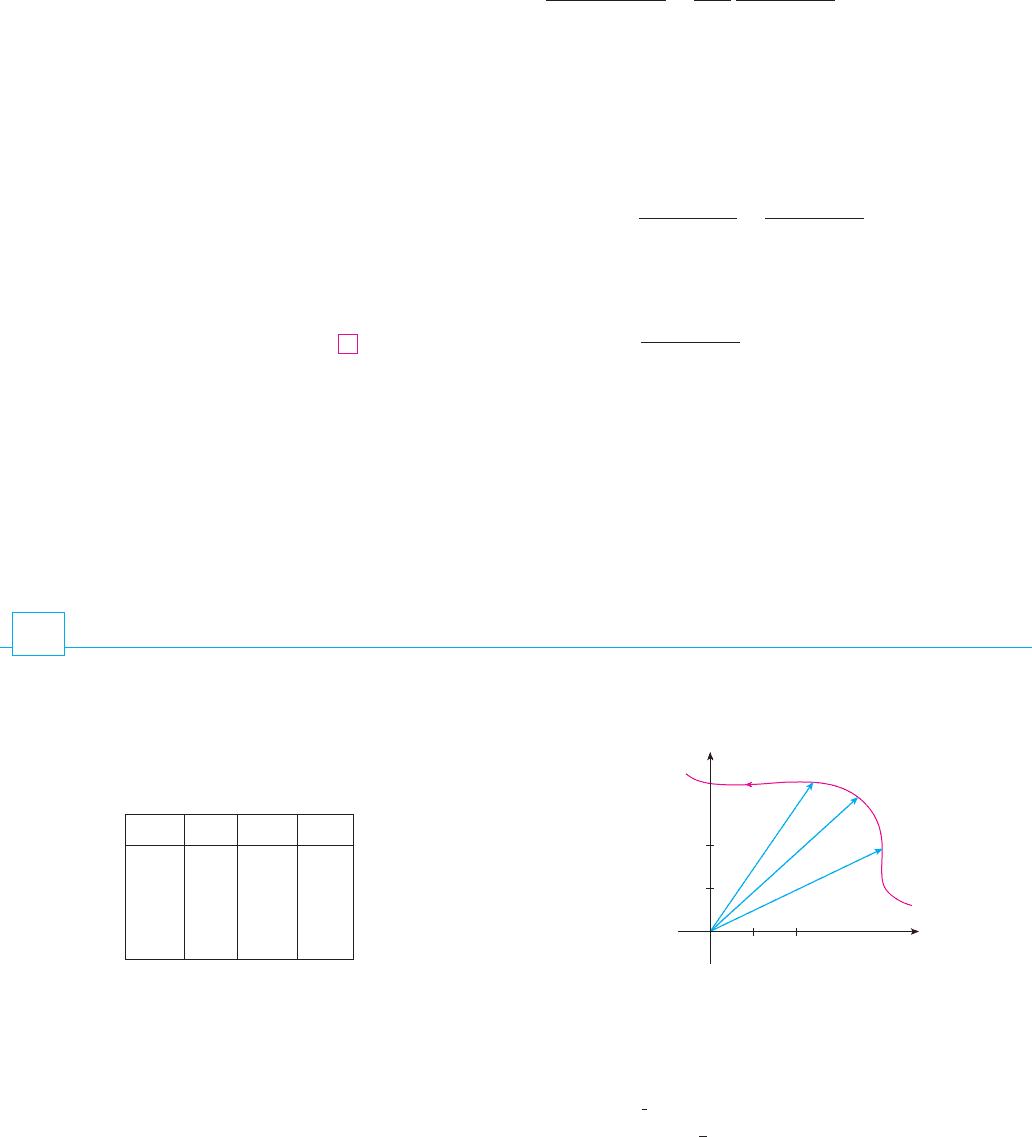
where . Then
where . But
where . So
Writing , we obtain the equation
Comparing with Theorem 11.6.6, we see that Equation 12 is the polar equation of a conic
section with focus at the origin and eccentricity . We know that the orbit of a planet is a
closed curve and so the conic must be an ellipse.
This completes the derivation of Kepler’s First Law. We will guide you through the der-
ivation of the Second and Third Laws in the Applied Project on page 884. The proofs of
these three laws show that the methods of this chapter provide a powerful tool for describ-
ing some of the laws of nature.
e
r 苷
ed
1 e cos
12
d 苷 h
2
兾c
r 苷
h
2
兾共GM兲
1 e cos
苷
eh
2
兾c
1 e cos
h 苷
ⱍ
h
ⱍ
r ⴢ 共v h兲 苷 共r v兲 ⴢ h 苷 h ⴢ h 苷
ⱍ
h
ⱍ
2
苷 h
2
e 苷 c兾共GM兲
r 苷
r ⴢ 共v h兲
GM c cos
苷
1
GM
r ⴢ 共v h兲
1 e cos
c 苷
ⱍ
c
ⱍ
882
||||
CHAPTER 14 VECTOR FUNCTIONS
(d) Draw an approximation to the vector v(2) and estimate the
speed of the particle at .
3–8 Find the velocity, acceleration, and speed of a particle with
the given position function. Sketch the path of the particle and
draw the velocity and acceleration vectors for the specified value
of .
3. ,
4. , t 苷 1r共t兲 苷
具
2 t, 4
s
t
典
t 苷 2r共t兲 苷
具
1
2
t
2
, t
典
t
y
x
0
2
1
2
1
r(2.4)
r(2)
r(1.5)
t 苷 2
1. The table gives coordinates of a particle moving through space
along a smooth curve.
(a) Find the average velocities over the time intervals [0, 1],
[0.5, 1], [1, 2], and [1, 1.5].
(b) Estimate the velocity and speed of the particle at .
2. The figure shows the path of a particle that moves with position
vector at time .
(a) Draw a vector that represents the average velocity of the
particle over the time interval .
(b) Draw a vector that represents the average velocity over the
time interval .
(c) Write an expression for the velocity vector v(2).
1.5 t 2
2 t 2.4
tr共t兲
t 苷 1
EXERCISES
14.4
txy
0 2.7 9.8 3.7
0.5
3.5 7.2 3.3
1.0
4.5 6.0 3.0
1.5
5.9 6.4 2.8
2.0 7.3 7.8 2.7
z

26. A gun is fired with angle of elevation . What is the
muzzle speed if the maximum height of the shell is 500 m?
27. A gun has muzzle speed . Find two angles of eleva-
tion that can be used to hit a target 800 m away.
28. A batter hits a baseball 3 ft above the ground toward the
center field fence, which is 10 ft high and 400 ft from home
plate. The ball leaves the bat with speed at an
angle above the horizontal. Is it a home run? (In other
words, does the ball clear the fence?)
29. A medieval city has the shape of a square and is protected
by walls with length 500 m and height 15 m. You are the
commander of an attacking army and the closest you can get
to the wall is 100 m. Your plan is to set fire to the city by cat-
apulting heated rocks over the wall (with an initial speed of
). At what range of angles should you tell your men to
set the catapult? (Assume the path of the rocks is perpendicu-
lar to the wall.)
30. A ball with mass 0.8 kg is thrown southward into the air with
a speed of at an angle of to the ground. A west
wind applies a steady force of 4 N to the ball in an easterly
direction. Where does the ball land and with what speed?
;
31. Water traveling along a straight portion of a river normally
flows fastest in the middle, and the speed slows to almost
zero at the banks. Consider a long straight stretch of river
flowing north, with parallel banks 40 m apart. If the maxi-
mum water speed is 3 , we can use a quadratic function
as a basic model for the rate of water flow units from the
west bank: .
(a) A boat proceeds at a constant speed of from a point
on the west bank while maintaining a heading perpen-
dicular to the bank. How far down the river on the oppo-
site bank will the boat touch shore? Graph the path of the
boat.
(b) Suppose we would like to pilot the boat to land at the
point on the east bank directly opposite . If we main-
tain a constant speed of and a constant heading,
find the angle at which the boat should head. Then graph
the actual path the boat follows. Does the path seem
realistic?
32. Another reasonable model for the water speed of the river in
Exercise 31 is a sine function: . If a
boater would like to cross the river from to with con-
stant heading and a constant speed of , determine the
angle at which the boat should head.
33–38 Find the tangential and normal components of the acceler-
ation vector.
33.
34.
36.
r共t兲 苷 t i t
2
j 3t k
r共t兲 苷 cos t i sin t j t k
35.
r共t兲 苷 共1 t兲
i 共t
2
2t兲
j
r共t兲 苷 共3t t
3
兲
i 3t
2
j
5 m兾s
BA
f 共x兲 苷 3 sin共
x兾40兲
5 m兾s
AB
A
5 m兾s
f 共x兲 苷
3
400
x共40 x兲
x
m兾s
3030 m兾s
80 m兾s
50
115 ft兾s
150 m兾s
30
5. ,
6. ,
7. ,
8. ,
9–14 Find the velocity, acceleration, and speed of a particle with
the given position function.
9.
10.
12.
13.
14.
15–16 Find the velocity and position vectors of a particle that has
the given acceleration and the given initial velocity and position.
15. ,,
16. ,,
17–18
(a) Find the position vector of a particle that has the given accel-
eration and the specified initial velocity and position.
;
(b) Use a computer to graph the path of the particle.
17. ,,
18. ,,
The position function of a particle is given by
. When is the speed a minimum?
20. What force is required so that a particle of mass has the
position function ?
21. A force with magnitude 20 N acts directly upward from the
-plane on an object with mass 4 kg. The object starts at the
origin with initial velocity . Find its position
function and its speed at time .
Show that if a particle moves with constant speed, then the
velocity and acceleration vectors are orthogonal.
23. A projectile is fired with an initial speed of 500 m兾s and
angle of elevation . Find (a) the range of the projectile,
(b) the maximum height reached, and (c) the speed at impact.
24. Rework Exercise 23 if the projectile is fired from a position
200 m above the ground.
A ball is thrown at an angle of to the ground. If the ball
lands 90 m away, what was the initial speed of the ball?
45
25.
30
22.
t
v共0兲 苷 i j
xy
r共t兲 苷 t
3
i t
2
j t
3
k
m
r共t兲 苷 具t
2
, 5t, t
2
16t典
19.
r共0兲 苷 j kv共0兲 苷 ka共t兲 苷 t i e
t
j e
t
k
r共0兲 苷 jv共0兲 苷 ia共t兲 苷 2t i sin t j cos 2t k
r共0兲 苷 j kv共0兲 苷 ia共t兲 苷 2 i 6t j 12t
2
k
r共0兲 苷 iv共0兲 苷 ka共t兲 苷 i 2 j
r共t兲 苷 t sin t i t cos t j t
2
k
r共t兲 苷 e
t
共cos t i sin t j t k兲
r共t兲 苷 t
2
i ln t j t k
r共t兲 苷
s
2
t i e
t
j e
t
k
11.
r共t兲 苷 具2 cos t, 3t, 2 sin t 典
r共t兲 苷 具t
2
1, t
3
, t
2
1典
t 苷 0r共t兲 苷 t i 2 cos t
j sin t
k
t 苷 1r共t兲 苷 t i t
2
j 2
k
t 苷 0r共t兲 苷 e
t
i e
2t
j
t 苷
兾3r共t兲 苷 3 cos t i 2 sin t j
SECTION 14.4 MOTION IN SPACE: VELOCITY AND ACCELERATION
||||
883
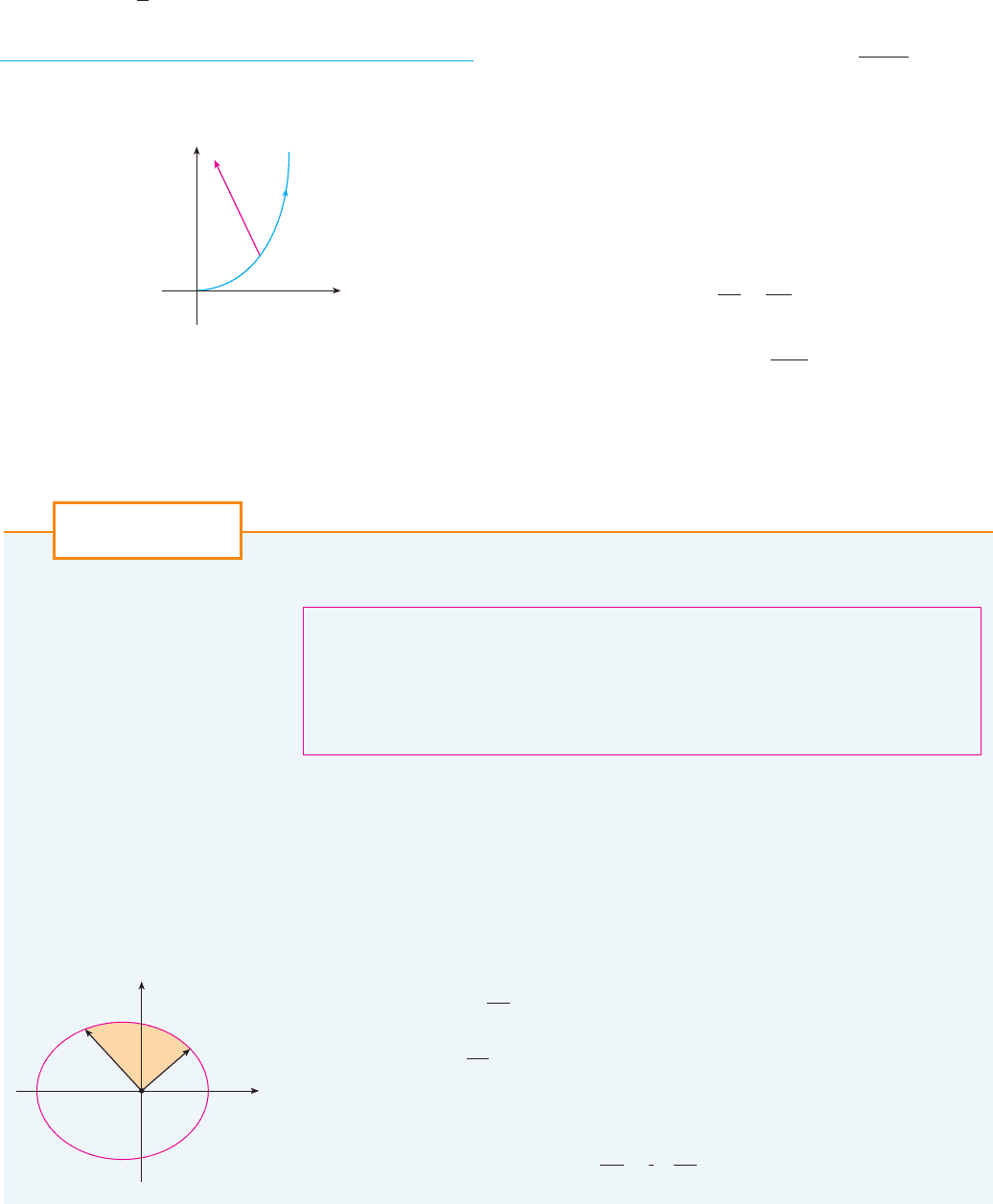
41. The position function of a spaceship is
and the coordinates of a space station are . The captain
wants the spaceship to coast into the space station. When
should the engines be turned off?
42. A rocket burning its onboard fuel while moving through space
has velocity and mass at time . If the exhaust gases
escape with velocity relative to the rocket, it can be deduced
from Newton’s Second Law of Motion that
(a) Show that .
(b) For the rocket to accelerate in a straight line from rest to
twice the speed of its own exhaust gases, what fraction of
its initial mass would the rocket have to burn as fuel?
v共t兲 苷 v共0兲 ln
m共0兲
m共t兲
v
e
m
dv
dt
苷
dm
dt
v
e
v
e
tm共t兲v共t兲
共6, 4, 9兲
r共t兲 苷 共3 t兲
i 共2 ln t兲
j
冉
7
4
t
2
1
冊
k
37.
38.
39. The magnitude of the acceleration vector is . Use the
figure to estimate the tangential and normal components of .
40. If a particle with mass moves with position vector , then
its angular momentum is defined as and
its torque as . Show that .
Deduce that if for all , then is constant. (This is
the law of conservation of angular momentum.)
L共t兲t
共t兲 苷 0
L共t兲 苷
共t兲
共t兲 苷 mr共t兲 a共t兲
L共t兲 苷 mr共t兲 v共t兲
r共t兲m
y
x0
a
a
10 cm兾s
2
a
r共t兲 苷 t i cos
2
t j sin
2
t k
r共t兲 苷 e
t
i
s
2
t j e
t
k
884
||||
CHAPTER 14 VECTOR FUNCTIONS
Johannes Kepler stated the following three laws of planetary motion on the basis of masses of
data on the positions of the planets at various times.
KEPLER’S LAWS
1. A planet revolves around the sun in an elliptical orbit with the sun at one focus.
2. The line joining the sun to a planet sweeps out equal areas in equal times.
3. The square of the period of revolution of a planet is proportional to the cube of the length
of the major axis of its orbit.
Kepler formulated these laws because they fitted the astronomical data. He wasn’t able to see
why they were true or how they related to each other. But Sir Isaac Newton, in his Principia
Mathematica of 1687, showed how to deduce Kepler’s three laws from two of Newton’s own
laws, the Second Law of Motion and the Law of Universal Gravitation. In Section 14.4 we
proved Kepler’s First Law using the calculus of vector functions. In this project we guide you
through the proofs of Kepler’s Second and Third Laws and explore some of their consequences.
1. Use the following steps to prove Kepler’s Second Law. The notation is the same as in
the proof of the First Law in Section 14.4. In particular, use polar coordinates so that
.
(a) Show that .
(b) Deduce that .
(c) If is the area swept out by the radius vector in the time interval
as in the figure, show that
dA
dt
苷
1
2
r
2
d
dt
关t
0
, t兴r 苷 r共t兲A 苷 A共t兲
r
2
d
dt
苷 h
h 苷 r
2
d
dt
k
r 苷 共r cos
兲
i 共r sin
兲
j
KEPLER’S LAWS
APPLIED
PROJECT
0
r(t)
r(t¸)
A(t)
x
y

(d) Deduce that
This says that the rate at which is swept out is constant and proves Kepler’s Second
Law.
2. Let be the period of a planet about the sun; that is, is the time required for it to travel once
around its elliptical orbit. Suppose that the lengths of the major and minor axes of the ellipse
are and .
(a) Use part (d) of Problem 1 to show that .
(b) Show that .
(c) Use parts (a) and (b) to show that .
This proves Kepler’s Third Law. [Notice that the proportionality constant is
independent of the planet.]
3. The period of the earth’s orbit is approximately 365.25 days. Use this fact and Kepler’s
Third Law to find the length of the major axis of the earth’s orbit. You will need the mass of
the sun, kg, and the gravitational constant, 兾kg .
4. It’s possible to place a satellite into orbit about the earth so that it remains fixed above a
given location on the equator. Compute the altitude that is needed for such a satellite. The
earth’s mass is ; its radius is . (This orbit is called the Clarke
Geosynchronous Orbit after Arthur C. Clarke, who first proposed the idea in 1945. The first
such satellite, Syncom 2, was launched in July 1963.)
6.37 10
6
m5.98 10
24
kg
2
G 苷 6.67 10
11
Nm
2
M 苷 1.99 10
30
4
2
兾共GM兲
T
2
苷
4
2
GM
a
3
h
2
GM
苷 ed 苷
b
2
a
T 苷 2
ab兾h
2b2a
TT
A
dA
dt
苷
1
2
h 苷 constant
CHAPTER 14 REVIEW
||||
885
REVIEW
CONCEPT CHECK
14
6. (a) What is the definition of curvature?
(b) Write a formula for curvature in terms of and .
(c) Write a formula for curvature in terms of and .
(d) Write a formula for the curvature of a plane curve with
equation .
7. (a) Write formulas for the unit normal and binormal vectors of
a smooth space curve .
(b) What is the normal plane of a curve at a point? What is the
osculating plane? What is the osculating circle?
8. (a) How do you find the velocity, speed, and acceleration of a
particle that moves along a space curve?
(b) Write the acceleration in terms of its tangential and normal
components.
9. State Kepler’s Laws.
r共t兲
y 苷 f 共x兲
r共t兲r共t兲
T共t兲r共t兲
1. What is a vector function? How do you find its derivative and
its integral?
2. What is the connection between vector functions and space
curves?
3. How do you find the tangent vector to a smooth curve at a
point? How do you find the tangent line? The unit tangent
vector?
4. If and are differentiable vector functions, is a scalar, and
is a real-valued function, write the rules for differentiating
the following vector functions.
(a) (b) (c)
(d) (e) (f)
5. How do you find the length of a space curve given by a vector
function r共t兲?
u共 f 共t兲兲u共t兲 v共t兲u共t兲 ⴢ v共t兲
f 共t兲 u共t兲cu共t兲u共t兲 v共t兲
f
cvu

Determine whether the statement is true or false. If it is true, explain why.
If it is false, explain why or give an example that disproves the statement.
1. The curve with vector equation is
a line.
2. The derivative of a vector function is obtained by differen-
tiating each component function.
3. If and are differentiable vector functions, then
4. If is a differentiable vector function, then
d
dt
ⱍ
r共t兲
ⱍ
苷
ⱍ
r共t兲
ⱍ
r共t兲
d
dt
关u共t兲 v共t兲兴 苷 u共t兲 v共t兲
v共t兲u共t兲
r共t兲 苷 t
3
i 2t
3
j 3t
3
k
5. If is the unit tangent vector of a smooth curve, then the
curvature is .
6. The binormal vector is .
7. Suppose is twice continuously differentiable. At an inflection
point of the curve , the curvature is 0.
8. If for all , the curve is a straight line.
9. If for all , then is a constant.
10. If for all , then is orthogonal to for all .
11. The osculating circle of a curve C at a point has the same
tangent vector, normal vector, and curvature as C at that
point.
12. Different parametrizations of the same curve result in identical
tangent vectors at a given point on the curve.
tr共t兲r共t兲t
ⱍ
r共t兲
ⱍ
苷 1
ⱍ
r共t兲
ⱍ
t
ⱍ
r共t兲
ⱍ
苷 1
t
共t兲 苷 0
y 苷 f 共x兲
f
B共t兲 苷 N共t兲 T共t兲
苷
ⱍ
dT兾dt
ⱍ
T共t兲
TRUE-FALSE QUIZ
1. (a) Sketch the curve with vector function
(b) Find and .
2. Let
.
(a) Find the domain of .
(b) Find .
(c) Find .
3. Find a vector function that represents the curve of intersection
of the cylinder and the plane .
;
4. Find parametric equations for the tangent line to the curve
, , at the point .
Graph the curve and the tangent line on a common screen.
5. If , evaluate .
6. Let be the curve with equations , ,
. Find (a) the point where intersects the -plane,
(b) parametric equations of the tangent line at , and
(c) an equation of the normal plane to at .
7. Use Simpson’s Rule with to estimate the length of
the arc of the curve with equations , , ,
.
8. Find the length of the curve ,
.
9. The helix intersects the curve
at the point . Find the
angle of intersection of these curves.
10. Reparametrize the curve
with respect to arc length measured from the point in
the direction of increasing .t
共1, 0, 1兲
r共t兲 苷 e
t
i e
t
sin t j e
t
cos t k
共1, 0, 0兲r
2
共t兲 苷 共1 t兲i t
2
j t
3
k
r
1
共t兲 苷 cos t i sin t j t k
0 t 1
r共t兲 苷 具2t
3兾2
, cos 2t, sin 2t 典
0 t 3
z 苷 t
4
y 苷 t
3
x 苷 t
2
n 苷 6
共1, 1, 0兲C
共1, 1, 0兲
xzCz 苷 ln t
y 苷 2t 1x 苷 2 t
3
C
x
1
0
r共t兲 dtr共t兲 苷 t
2
i t cos
t
j sin
t
k
(
1,
s
3, 2
)
z 苷 2 sin 3ty 苷 2 sin 2tx 苷 2 sin t
x z 苷 5x
2
y
2
苷 16
r共t兲
lim
t
l
0
r共t兲
r
r共t兲 苷 具
s
2 t
, 共e
t
1兲兾t, ln共t 1兲典
r共t兲r共t兲
t 0r共t兲 苷 t i cos
t j sin
t k
11. For the curve given by , find
(a) the unit tangent vector
(b) the unit normal vector
(c) the curvature
12. Find the curvature of the ellipse , at the
points and .
13. Find the curvature of the curve at the point .
;
14. Find an equation of the osculating circle of the curve
at the origin. Graph both the curve and its oscu-
lating circle.
15. Find an equation of the osculating plane of the curve
, , at the point .
16. The figure shows the curve traced by a particle with posi-
tion vector at time .
(a) Draw a vector that represents the average velocity of the
particle over the time interval .
(b) Write an expression for the velocity v(3).
(c) Write an expression for the unit tangent vector T(3) and
draw it.
y
x
0
C
r(3.2)
r(3)
1
1
3 t 3.2
tr共t兲
C
共0,
, 1兲z 苷 cos 2ty 苷 tx 苷 sin 2t
y 苷 x
4
x
2
共1, 1兲y 苷 x
4
共0, 4兲共3, 0兲
y 苷 4 sin tx 苷 3 cos t
r共t兲 苷
具
1
3
t
3
,
1
2
t
2
, t
典
EXERCISES
886
||||
CHAPTER 14 VECTOR FUNCTIONS
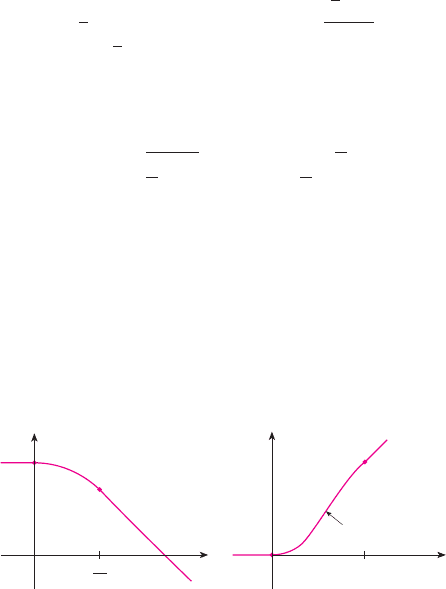
(c) Determine the Coriolis acceleration of a particle that moves
on a rotating disk according to the equation
22. In designing transfer curves to connect sections of straight rail-
road tracks, it’s important to realize that the acceleration of the
train should be continuous so that the reactive force exerted by
the train on the track is also continuous. Because of the formu-
las for the components of acceleration in Section 14.4, this will
be the case if the curvature varies continuously.
(a) A logical candidate for a transfer curve to join existing
tracks given by for and for
might be the function ,
, whose graph is the arc of the circle shown
in the figure. It looks reasonable at first glance. Show that
the function
is continuous and has continuous slope, but does not have
continuous curvature. Therefore is not an appropriate
transfer curve.
;
(b) Find a fifth-degree polynomial to serve as a transfer curve
between the following straight line segments: for
and for . Could this be done with a
fourth-degree polynomial? Use a graphing calculator or
computer to sketch the graph of the “connected” function
and check to see that it looks like the one in the figure.
y
x
0
y=x
y=0
transfer curve
1
y
x
0
y=F(x)
1
1
œ
„
2
x 1y 苷 xx 0
y 苷 0
f
F共x兲 苷
再
1
s
1 x
2
s
2
x
if x 0
if 0
x
1兾
s
2
if x 1兾
s
2
0
x
1兾
s
2
f 共x兲 苷
s
1 x
2
x 1兾
s
2
y 苷
s
2 x
x 0y 苷 1
r共t兲 苷 e
t
cos
t i e
t
sin
t j
17. A particle moves with position function
. Find the velocity, speed, and
acceleration of the particle.
18. A particle starts at the origin with initial velocity .
Its acceleration is . Find its position
function.
19. An athlete throws a shot at an angle of to the horizontal
at an initial speed of 43 ft兾s. It leaves his hand 7 ft above the
ground.
(a) Where is the shot 2 seconds later?
(b) How high does the shot go?
(c) Where does the shot land?
20. Find the tangential and normal components of the acceleration
vector of a particle with position function
21. A disk of radius is rotating in the counterclockwise direction
at a constant angular speed . A particle starts at the center of
the disk and moves toward the edge along a fixed radius so that
its position at time , , is given by , where
(a) Show that the velocity of the particle is
where is the velocity of a point on the edge of
the disk.
(b) Show that the acceleration of the particle is
where is the acceleration of a point on the rim
of the disk. The extra term is called the Coriolis accel-
eration; it is the result of the interaction of the rotation of
the disk and the motion of the particle. One can obtain a
physical demonstration of this acceleration by walking
toward the edge of a moving merry-go-round.
2v
d
a
d
苷 R共t兲
a 苷 2v
d
t a
d
a
v
d
苷 R共t兲
v 苷 cos
t i sin
t j t v
d
v
R共t兲 苷 cos
t i sin
t j
r共t兲 苷 t R共t兲t 0t
1
r共t兲 苷 t i 2t j t
2
k
45
a共t兲 苷 6t i 12t
2
j 6t
k
i j 3k
r共t兲 苷 t ln t i t
j e
t
k
CHAPTER 14 REVIEW
||||
887
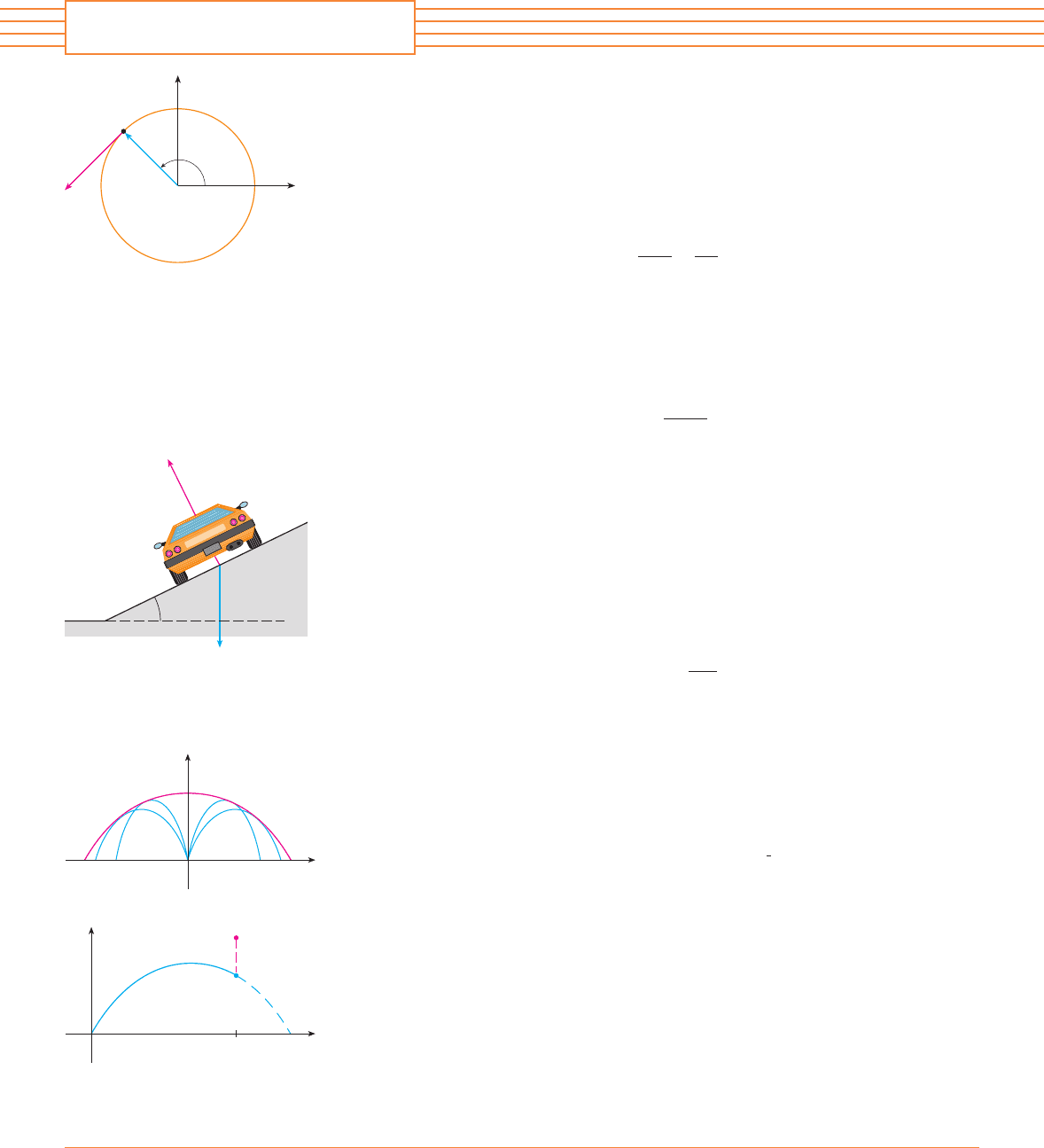
888
1. A particle moves with constant angular speed around a circle whose center is at the origin
and whose radius is . The particle is said to be in uniform circular motion. Assume that the
motion is counterclockwise and that the particle is at the point when . The position
vector at time is .
(a) Find the velocity vector and show that . Conclude that is tangent to the circle
and points in the direction of the motion.
(b) Show that the speed of the particle is the constant . The period of the particle is
the time required for one complete revolution. Conclude that
(c) Find the acceleration vector . Show that it is proportional to and that it points toward
the origin. An acceleration with this property is called a centripetal acceleration. Show
that the magnitude of the acceleration vector is .
(d) Suppose that the particle has mass . Show that the magnitude of the force that is
required to produce this motion, called a centripetal force, is
2. A circular curve of radius on a highway is banked at an angle so that a car can safely
traverse the curve without skidding when there is no friction between the road and the tires.
The loss of friction could occur, for example, if the road is covered with a film of water or ice.
The rated speed of the curve is the maximum speed that a car can attain without skidding.
Suppose a car of mass is traversing the curve at the rated speed Two forces are acting on
the car: the vertical force, , due to the weight of the car, and a force exerted by, and
normal to, the road. (See the figure.)
The vertical component of balances the weight of the car, so that . The
horizontal component of produces a centripetal force on the car so that, by Newton’s Sec-
ond Law and part (d) of Problem 1,
(a) Show that .
(b) Find the rated speed of a circular curve with radius 400 ft that is banked at an angle of
(c) Suppose the design engineers want to keep the banking at , but wish to increase the
rated speed by . What should the radius of the curve be?
3. A projectile is fired from the origin with angle of elevation and initial speed . Assuming
that air resistance is negligible and that the only force acting on the projectile is gravity, , we
showed in Example 5 in Section 14.4 that the position vector of the projectile is
We also showed that the maximum horizontal distance of the projectile is achieved when
and in this case the range is .
(a) At what angle should the projectile be fired to achieve maximum height and what is the
maximum height?
(b) Fix the initial speed and consider the parabola , whose graph is
shown in the figure. Show that the projectile can hit any target inside or on the boundary
of the region bounded by the parabola and the -axis, and that it can’t hit any target out-
side this region.
(c) Suppose that the gun is elevated to an angle of inclination in order to aim at a target that
is suspended at a height directly over a point units downrange. The target is released
at the instant the gun is fired. Show that the projectile always hits the target, regardless of
the value , provided the projectile does not hit the ground “before” .D
v
0
Dh
x
x
2
2Ry R
2
苷 0v
0
R 苷 v
2
0
兾t
苷 45
r共t兲 苷 共
v
0
cos
兲t i
[
共v
0
sin
兲t
1
2
tt
2
]
j
t
v
0
50%
12
12.
v
2
R
苷 Rt tan
ⱍ
F
ⱍ
sin
苷
mv
2
R
R
F
ⱍ
F
ⱍ
cos
苷 mtF
Fmt
v
R
.m
v
R
R
ⱍ
F
ⱍ
苷
m
ⱍ
v
ⱍ
2
R
Fm
ⱍ
a
ⱍ
苷 R
2
ra
T 苷
2
R
ⱍ
v
ⱍ
苷
2
T
R
ⱍ
v
ⱍ
vv ⴢ r 苷 0v
r共t兲 苷 R cos
t i R sin
t jt 0
t 苷 0共R, 0兲
R
P
PROBLEMS PLUS
FIGURE FOR PROBLEM 1
r
v
v t
y
x
mg
F
¨
FIGURE FOR PROBLEM 2
0
R
_R
0
D
y
x
y
x
FIGURE FOR PROBLEM 3
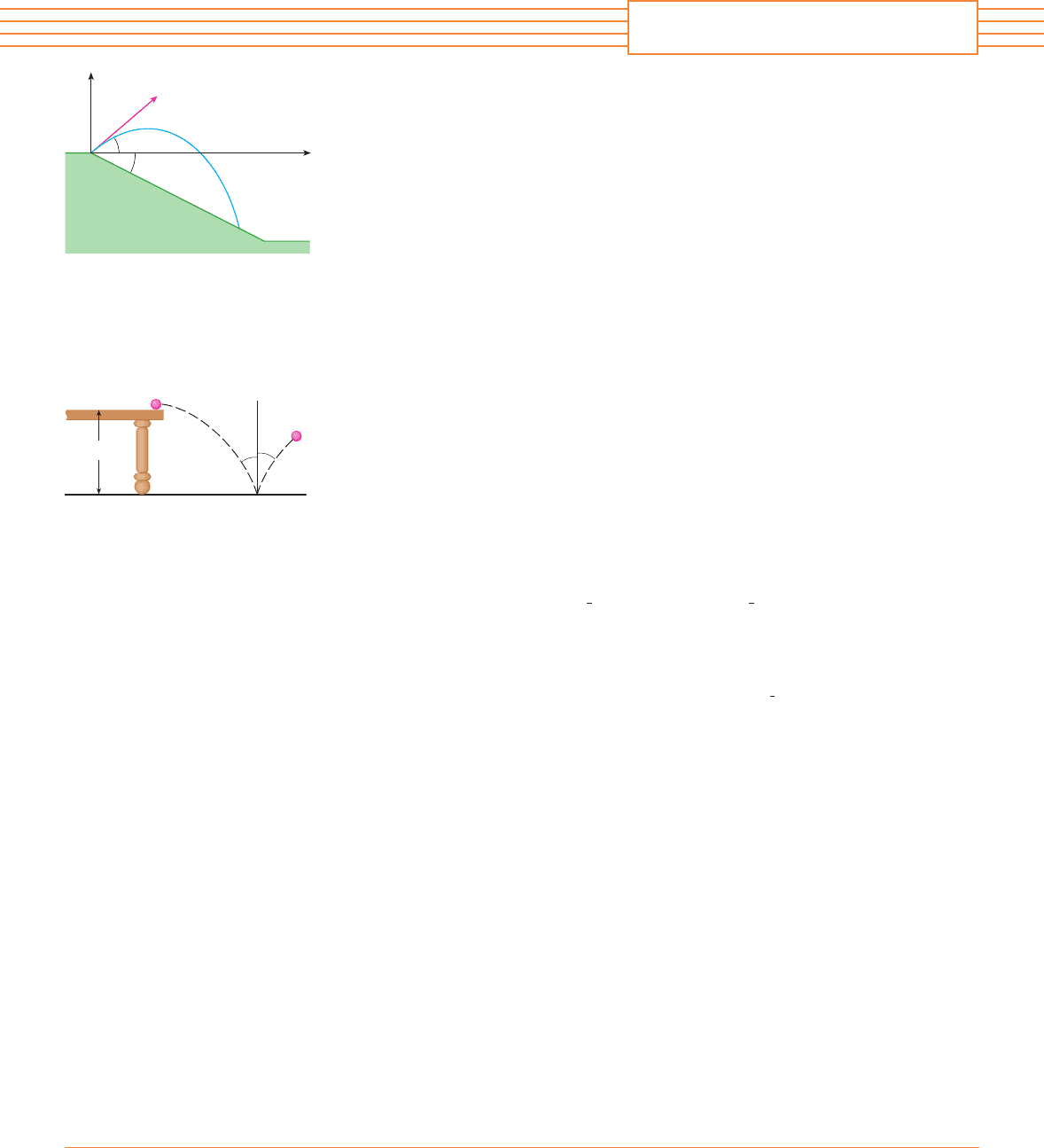
889
4. (a) A projectile is fired from the origin down an inclined plane that makes an angle with the
horizontal. The angle of elevation of the gun and the initial speed of the projectile are
and , respectively. Find the position vector of the projectile and the parametric equations
of the path of the projectile as functions of the time . (Ignore air resistance.)
(b) Show that the angle of elevation that will maximize the downhill range is the angle
halfway between the plane and the vertical.
(c) Suppose the projectile is fired up an inclined plane whose angle of inclination is . Show
that, in order to maximize the (uphill) range, the projectile should be fired in the direction
halfway between the plane and the vertical.
(d) In a paper presented in 1686, Edmond Halley summarized the laws of gravity and projectile
motion and applied them to gunnery. One problem he posed involved firing a projectile to
hit a target a distance up an inclined plane. Show that the angle at which the projectile
should be fired to hit the target but use the least amount of energy is the same as the angle
in part (c). (Use the fact that the energy needed to fire the projectile is proportional to the
square of the initial speed, so minimizing the energy is equivalent to minimizing the initial
speed.)
5. A ball rolls off a table with a speed of 2 ft兾s. The table is 3.5 ft high.
(a) Determine the point at which the ball hits the floor and find its speed at the instant of
impact.
(b) Find the angle between the path of the ball and the vertical line drawn through the point
of impact. (See the figure.)
(c) Suppose the ball rebounds from the floor at the same angle with which it hits the floor, but
loses of its speed due to energy absorbed by the ball on impact. Where does the ball
strike the floor on the second bounce?
6. Find the curvature of the curve with parametric equations
;
7. If a projectile is fired with angle of elevation and initial speed , then parametric equations
for its trajectory are
(See Example 5 in Section 14.4.) We know that the range (horizontal distance traveled)
is maximized when . What value of maximizes the total distance traveled by the
projectile? (State your answer correct to the nearest degree.)
8. A cable has radius and length and is wound around a spool with radius without over-
lapping. What is the shortest length along the spool that is covered by the cable?
RLr
苷 45
x 苷 共
v cos
兲t y 苷 共v sin
兲t
1
2
tt
2
v
y 苷
y
t
0
cos
(
1
2
2
)
d
x 苷
y
t
0
sin
(
1
2
2
)
d
20%
R
t
v
0
PROBLEMS PLUS
a
¨
v¸
FIGURE FOR PROBLEM 4
x
y
¨
¨
3.5 ft
FIGURE FOR PROBLEM 5

890
PARTIAL
DERIVATIVES
15
So far we have dealt with the calculus of functions of a single variable. But, in the real
world, physical quantities often depend on two or more variables, so in this chapter
we turn our attention to functions of several variables and extend the basic ideas of
differential calculus to such functions.
Functions of two variables can be visualized by means of level curves, which con-
nect points where the function takes on a given value. Atmospheric pressure at a
given time is a function of longitude and latitude and is measured in millibars. Here
the level curves are called isobars and those pictured join locations that had the
same pressure on March 7, 2007. (The curves labeled 1028, for instance, connect
points with pressure 1028 mb.) Surface winds tend to flow from areas of high
pressure across the isobars toward areas of low pressure, and are strongest
where the isobars are tightly packed.
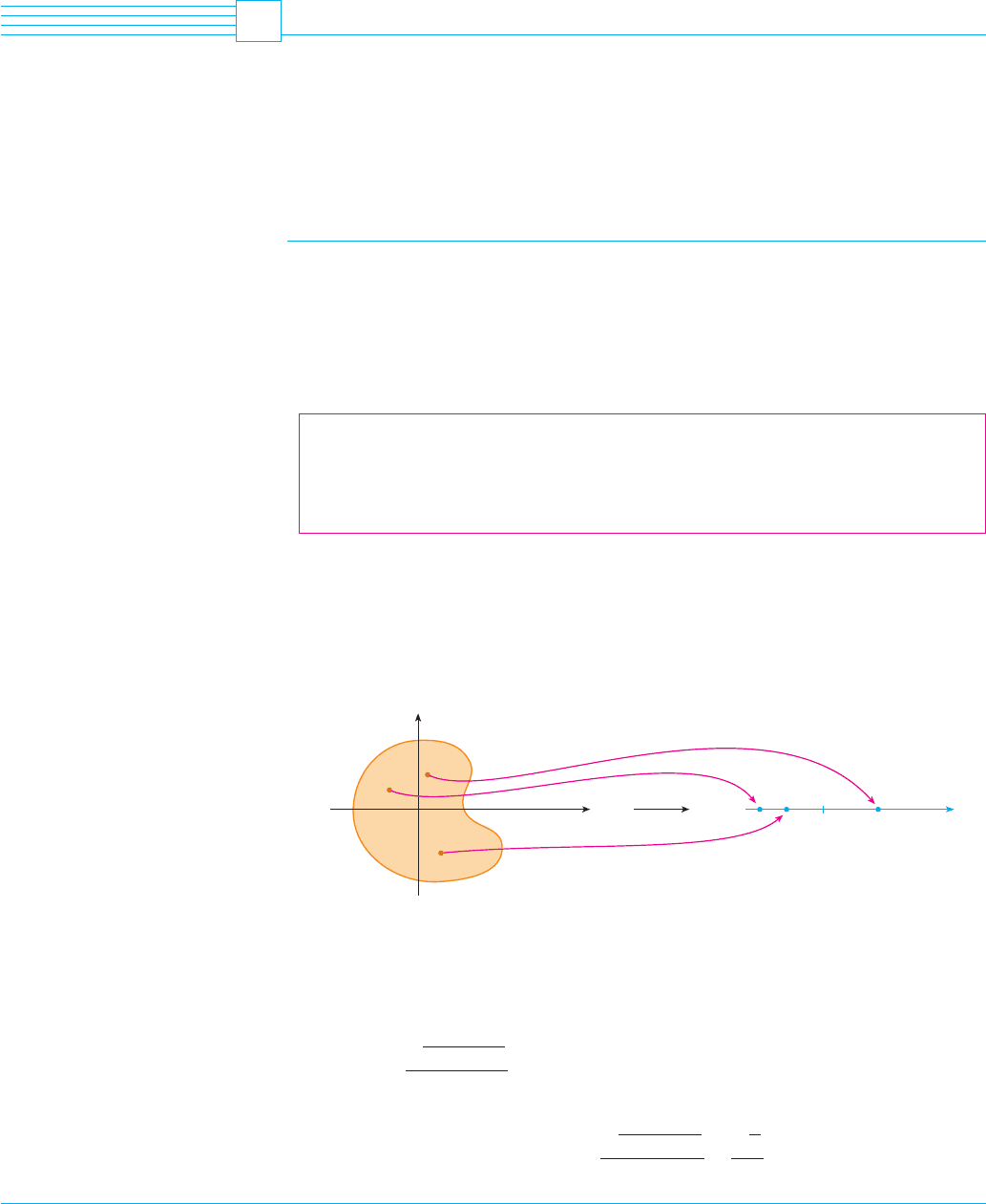
FUNCTIONS OF SEVERAL VARIABLES
In this section we study functions of two or more variables from four points of view:
N
verbally (by a description in words)
N
numerically (by a table of values)
N
algebraically (by an explicit formula)
N
visually (by a graph or level curves)
FUNCTIONS OF TWO VARIABLES
The temperature at a point on the surface of the earth at any given time depends on the
longitude and latitude of the point. We can think of as being a function of the two
variables and , or as a function of the pair . We indicate this functional dependence
by writing .
The volume of a circular cylinder depends on its radius and its height . In fact, we
know that . We say that is a function of and , and we write .
DEFINITION A function of two variables is a rule that assigns to each ordered
pair of real numbers in a set a unique real number denoted by . The
set is the domain of and its range is the set of values that takes on, that is,
.
We often write to make explicit the value taken on by at the general point
. The variables and are independent variables and is the dependent variable.
[Compare this with the notation for functions of a single variable.]
A function of two variables is just a function whose domain is a subset of and whose
range is a subset of . One way of visualizing such a function is by means of an arrow dia-
gram (see Figure 1), where the domain is represented as a subset of the -plane.
If a function is given by a formula and no domain is specified, then the domain of
is understood to be the set of all pairs for which the given expression is a well-
defined real number.
EXAMPLE 1 For each of the following functions, evaluate and find the domain.
(a) (b)
SOLUTION
(a) f 共3, 2兲 苷
s
3 ⫹ 2 ⫹ 1
3 ⫺ 1
苷
s
6
2
f 共x, y兲 苷 x ln共y
2
⫺ x兲f 共x, y兲 苷
s
x ⫹ y ⫹ 1
x ⫺ 1
f 共3, 2兲
共x, y兲
ff
FIGURE 1
y
x
0
0
z
D
f
f(a,b)
f(x,y)
(x,y)
(a,b)
xyD
⺢
⺢
2
y 苷 f 共x兲
zyx共x, y兲
fz 苷 f 共x, y兲
兵 f 共x, y兲
ⱍ
共x, y兲 僆 D其
ffD
f 共x, y兲D共x, y兲
f
V共r, h兲 苷
r
2
hhrVV 苷
r
2
h
hrV
T 苷 f 共x, y兲
共x, y兲yx
Tyx
T
15.1
891
